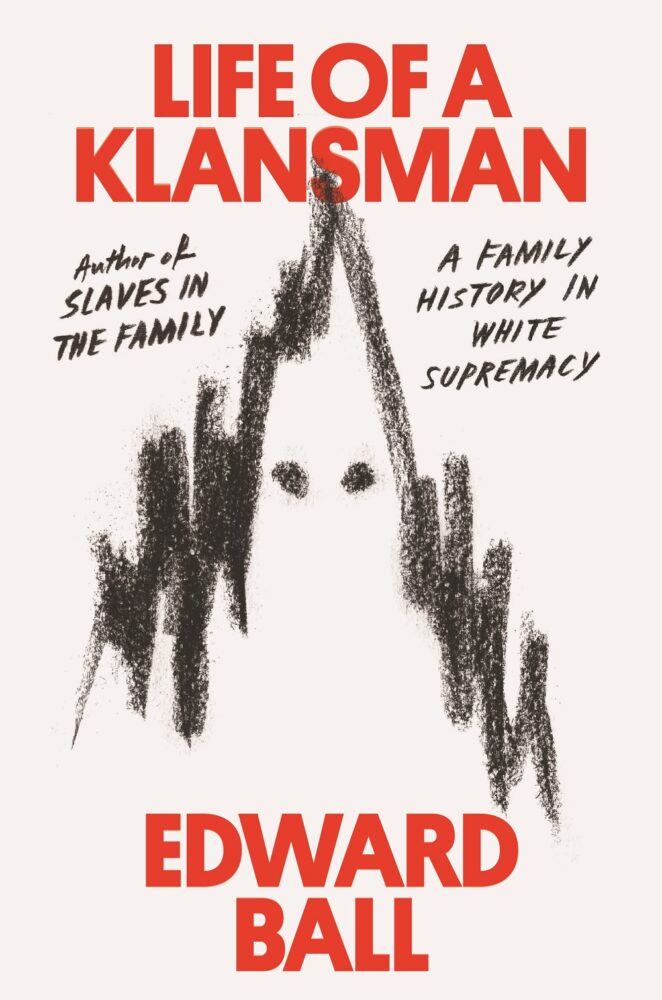Bookstand
Digging Up the Roots of the Family Tree
An author comes to terms with a Klansman in the family
Published: September 1, 2020
Last Updated: November 30, 2020

Farrar, Strauss, and Giroux
Ball makes plain that having a Klansman in the family is not a unique occurrence. By his estimation, half of whites in the United States could make such an assertion. At its peak in the 1920s, the Klan had upwards of four million members. “White supremacy is not a marginal ideology,” Ball writes. “It is the early build of the country. It is a foundation on which the social edifice rises, bedrock of institutions.” Far less common than white supremacy is the willingness of its successors to explore their connections to it. Ball’s family memoir runs counter to the tendency to disavow the unsettling history of whiteness while maintaining its attendant privileges. Rather, the author unearths the ugly roots of his family tree, creating a portrait of racial violence and its role in shaping both his personal ancestry and a nation’s identity.
Born in Savannah, Georgia, in 1959, Ball spent his teenage years in Metairie. His bestselling Slaves in the Family, a biographical account of his family’s slave-owning roots, won the National Book Award in 1998. Ball now lives in Connecticut and teaches at Yale University; Life of a Klansman is his sixth book, spurred by a return trip to New Orleans where he cleared out his departed mother’s house. A set of manila folders filed away in an oak desk served as a catalyst to closely examine his family history and the Klansman in its midst.
In 1840, New Orleans was home to the largest slave market in the country. Constant Lecorgne was still a young boy living in the city; after a death in the family resulted in his mother and father inheriting people, referred to as “items,” he became a young beneficiary of slavery. For Constant, the buying and selling of Black people was commonplace.
Ball takes readers through Constant’s childhood, depicting life in a booming metropolis where the relationship between nineteenth-century science and white supremacy positioned the city as a center for race theory. By 1860, New Orleans was the wealthiest city in the Confederacy. The Civil War would dramatically restructure the country, and by its end Louisiana would send fifty-five thousand white men to fight, half of whom were killed, wounded, or fatally stricken by disease. Following the war, the deep-seated racism of Confederate stalwarts was accompanied by newfound resentment. White men sought to set things right by way of violence. The New Orleans Massacre of 1866—a gruesome mass killing of Blacks carried out by police and firemen outside of the Mechanics’ Institute—is cited by Ball as an early manifestation of the white terror attributed to the Ku Klux Klan. In tracing the life of his family’s Klansman and describing the event he was almost certainly part of, the author attests to an unsettling feeling of association. “Because he acts on behalf of his family—our family, if you like—I have a feeling of wretchedness and shame,” he writes.
The expression “our family” betrays a fault in Ball’s narration. When writing, “I am advertising some of the venal things my predecessor did. But I am not delivering him to justice. I do not scold him: he is one of us,” it’s apparent that Ball is addressing a white audience. The instances of “we,” “us,” and “our” appearing throughout the book evince an inclination to exclude non-white readership. As Ball points out, it is important for white people to reconcile with the sordid history they inherit. Still, Life of a Klansman at times falls into the trap of centering whiteness, a corollary of the very privileges Ball seeks to come to terms with.
An adept researcher, the author thrives in his recounting of the past. While distressing, Life of a Klansman is an absorbing record of the hardening of racial categories and the inner workings of white supremacy. The author takes the reader through the Reconstruction era and rise of the KKK. He charts a life he describes as “insignificant and yet calamitous, strange but common,” all while making clear the impact wrought by a brutal legacy. Perhaps Ball’s greatest success in this book is his utilization of family biography and historical events to examine whiteness as a construct. Within his treatise is an invaluable aide-mémoire—white supremacy is not “a regional phenomenon.” In truth, white identity and its auxiliary biases were adopted by a nation en masse. It’s a recent history, one that continues to unfold to this day.
Andru Okun is a freelance writer living in New Orleans.
